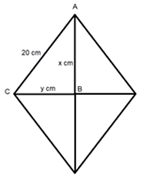Start learning 50% faster. Sign in now
Length of each side of the rhombus = 80 ÷ 4 = 20 cm
Let the length of longer diagonal be '2x' cm and that of smaller diagonal be '2y' cm.
So, (1/2) X 2x X 2y = 384
Or, xy = 192 
Now, since the diagonals of a rhombus are perpendicular bisectors of each other. So, ABC is a right angled triangle.
And, in triangle ABC, we have
x2 + y2 = 400
Since, (x + y)2 = x2 + y2 + 2xy
So, (x + y)2 = 400 + 2 X 192
Or, (x + y)2 = 784
So, x + y = 28
So, required sum = 28 X 2 = 56 cm
What is a deadlock in a computer system?
What is dynamic programming?
A problem is said to be NP-hard if:
Suppose we have a printer shared between various machines in a network, and any machine or computer in a network can send a print request to the printe...
Which data structure is used for efficiently implementing dynamic sets and supports operations like insert, delete, minimum, maximum, predecessor, and ...
Which method is commonly used for error detection at the Data Link Layer?
What is a resource in the context of deadlocks?
Which recovery strategy involves reinstalling the operating system and applications, followed by restoring user data from backups?
Which topology covers security, robust and eliminating traffic factor?
Which network layer protocol is responsible for multicasting, where a packet is sent to multiple destinations simultaneously?